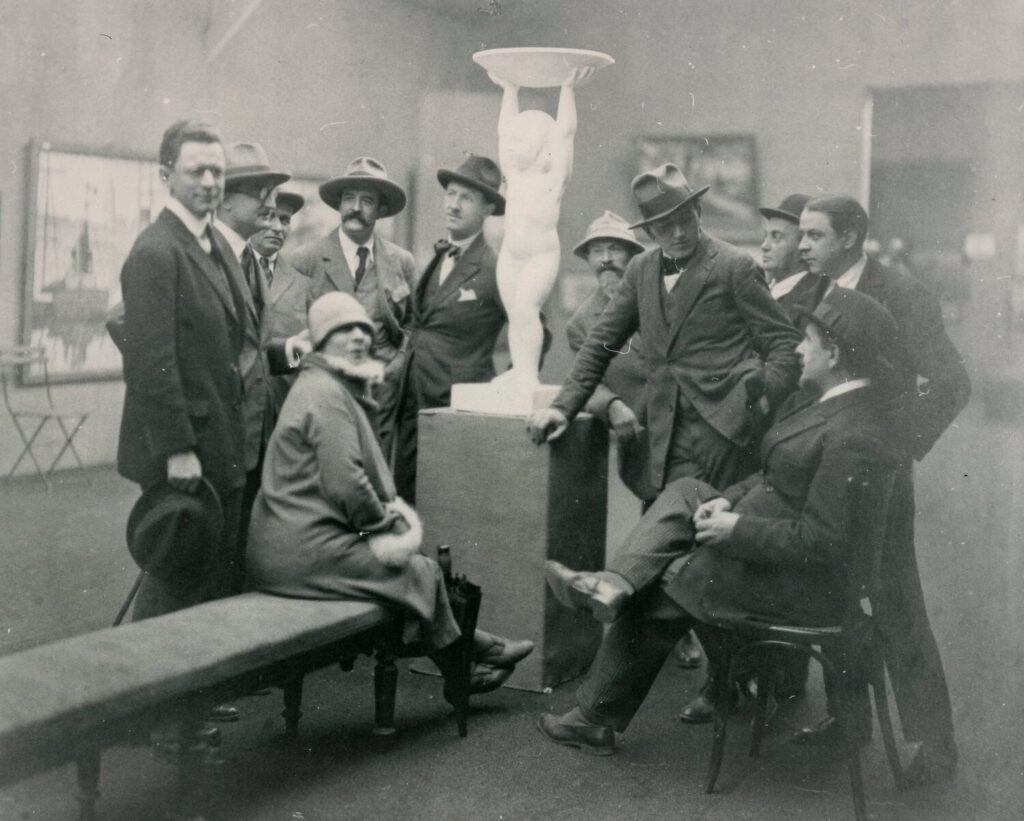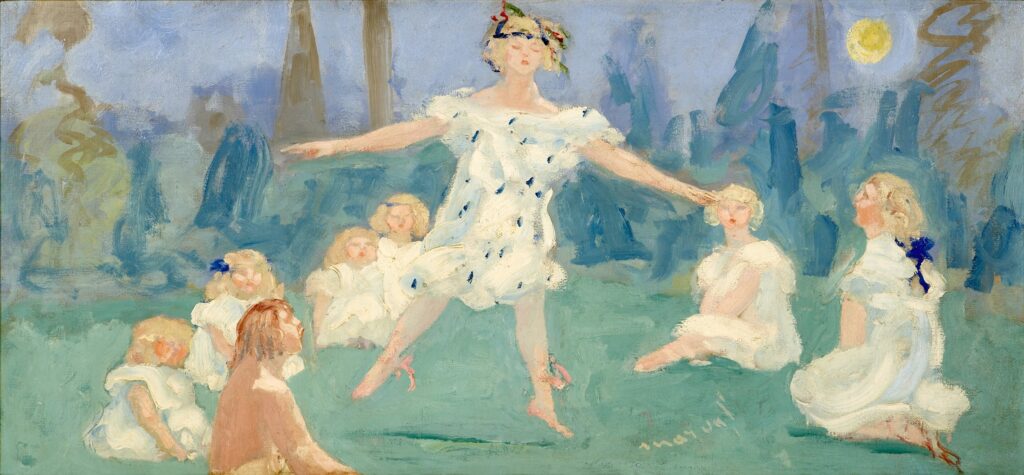Laura Knight in 5 Paintings: Capturing the Quotidian
An official war artist and the first woman to be made a dame of the British Empire, Laura Knight reached the top of her profession with her...
Natalia Iacobelli 2 January 2025
She was known as one of the greatest painters of her day and was a central figure of the Parisian art scene at the turn of the 20th century. She forged her way into a male-dominated art world, working alongside Henri Matisse, Albert Marquet, and Pablo Picasso. Yet, by the time of her death in 1932, she was virtually unknown. Now, thanks to a passionate Parisian art dealer and his family, this pioneering female artist is being placed back in the spotlight as she reclaims her place among the Fauves. Meet Jacqueline Marval.
Jacqueline Marval (born as Marie-Joséphine Vallet in 1866 in Quaix, France) was a French painter, lithographer, and sculptor whose luminous compositions pulsate with expressive power. Yet, Marval never intended to be an artist—in fact, she didn’t become a professional painter until she was in her thirties. Persuaded by her parents to become an educator, Marval earned her teaching degree in 1884. In 1886, she married Albertin Valentin, a travelling salesman, but their ill-fated union ended abruptly following the death of their infant son. To support herself, Marval took up a job in a clothing factory in Grenoble, where she worked as a tailor and embroiderer, making waistcoats, gilets, and vests.

Jacqueline Marval, Duchesse de Montbazon, 1904, private collection. Comité Jacqueline Marval.
In 1895, a radical desire for freedom and independence led Marval to move to Paris with her companion, Jules Flandrin, with whom she shared a studio. That same year, she adopted the pseudonym Jacqueline Marval, representing a breakage from her former life and the desire to reinvent herself.
When it came to painting, Marval was self-educated. In the beginning, she couldn’t afford canvases, so she painted on bed sheets.
The lack of money wouldn’t stop her passion; it was more important for her to paint than to sleep comfortably. So, she would tear her bed sheets to use them as canvases.
Director, Comité Jacquline Marval for DailyArt Magazine

Jacqueline Marval, Danseuse de Notre Dame, 1921. Comité Jacqueline Marval.
Living in the artistic enclave of Montparnasse, Marval was surrounded by artists, among them Joseph François, Georges Rouault, Charles Camoin, Albert Marquet, Henri Matisse, and Léon-Ernest Drivier. Her acquaintance with the most important art dealers in Paris, such as Ambroise Vollard and Berthe Weill—who devoted much of her career to promoting female artists—would be pivotal in securing her place as an artist in Paris.
Marval was known for her free-spirited and spontaneous nature, which was reflected in her art. She once rapidly produced paintings on cigar-box lids to show Gustave Moreau’s students the method of direct painting without embellishment.
Fed up with hearing about the claims and pretensions of Moreau’s students, she dashed off a couple of landscapes on cigar-box lids, ‘Just to teach Flandrin how it should be done.’
Hilary Spurling, The Unknown Matisse: A Life of Henri Matisse, the Early Years, 1869-1908, Alfred A. Knopf 1998.

Marval at the Galerie Druet, Paris, 1925. Comité Jacqueline Marval.
In 1901, Jacqueline Marval submitted her work to the Salon des Indépendents, where she exhibited 10 paintings. All were purchased by Ambroise Vollard. One of these paintings, Odalisque au Guépard, features the artist reclining in the nude, set against a lush green backdrop and accompanied by a cheetah. In this bold composition, Marval revisits a popular motif throughout the history of art, one that has been famously interpreted by scores of artists, among them Giorgione, Ingres, and Manet. However, this painting is particularly revolutionary. Painted six years before Paula Modersohn-Becker’s Self-portrait on Her Sixth Wedding Anniversary from 1906, Marval’s odalisque is likely the very first female nude self-portrait in the history of art.1

Jacqueline Marval, Odalisque au Guépard, 1900, private collection. Comité Jacqueline Marval.
Marval and her circle of artist friends became known as the Fauves, or wild beasts. Their use of saturated colors, rejection of detail, and fierce brushwork set them apart from their contemporaries. Color took on a new function—that of expressing emotion. In 1902, Marval exhibited her works at the Galerie Berthe Weill, alongside those of Flandrin, Marquet, and Matisse, marking the first time the young Fauves exhibited outside of the Salons. Marval would go on to exhibit widely not only within in France, but also internationally, from New York to Japan.
In her large-scale sweeping scene, Odalisques (from which Matisse openly drew inspiration), five women bear traits of the artist herself. In 1916, Marval’s Odalisques and Pablo Picasso’s Demoiselles d’Avignon were both selected by André Salmon for the Salon d’Antin exhibition. While Marval’s painting was already well-known and celebrated, it was the first time Picasso’s masterpiece was introduced to the public. Both feature five naked women in similar poses, eating grapes, set against a curtain. Might Marval’s Odalisques have also inspired Picasso’s Demoiselles d’Avignon?
The context surrounding the years of Les Demoiselles d’Avignon’s creation might lead us into thinking that Picasso would have seen the painting at Marval’s and Flandrin’s studio, 9 rue Campagne-Première, where other artists familiar with Picasso also lived and worked.
Jacqueline Marval: Iconographic Researches. Document courtesy of Comité Jacqueline Marval, 2023.
Strong women characterized by a sense of freedom permeate Marval’s body of works. In many of her paintings, we experience a symphony of stripes, polka dots, flowers—recalling Marval’s time working as a seamstress. Indeed, sewing is a recurring theme throughout her oeuvre, as well as that of female nudes, mythology, and the Russian ballet.
In 1913, Marval was selected to create eight panels that would decorate the Foyer de la Danse of the Théâtre des Champs-Élysées. Her dreamlike paintings depict various scenes from the Russian ballet, Daphne et Chloé, in a multitude of luminous colors.

Jacqueline Marval, Chloé et Les Enfants, 1913. Théâtre des Champs-Élysées, Paris. Comité Jacqueline Marval.
In the 1920s, Marval began visiting the seaside town of Biarritz with her friends. Among them was Paul Poiret, the master couturier who is credited for liberating women from tight-fitting clothes, namely the corset. Poiret invented the jupe-culotte, a skirt-pant combination that allowed women to ride bicycles and horses, and play sports, more comfortably. Marval created multiple painted compositions of Biarritz and its posh visitors. More than mere beach scenes, these paintings represent the dawn of a fashionable hobby among the upper milieus of French society.

Jacqueline Marval, Plage Rose, La Côte des Basques, 1923, private collection. Comité Jacqueline Marval.
In 1912, famed art critic Guillaume Apollinaire described Jacqueline Marval as “one of the most remarkable artists of our time.”2 Yet, while her contemporaries catapulted to fame, Marval gradually withdrew from society and was swiftly forgotten. Despite having produced more than 1,200 works in her lifetime, she died alone and in poverty.

Jacqueline Marval, Danseuse, 1909. Aware Women Artists.
Jacqueline Marval’s legacy would have been erased by time had it not been for Raphaël Roux dit Buisson, a passionate art dealer based in Paris. In 2020, Buisson founded the Comité Jacqueline Marval, an organization that aims to lift this female artist out of obscurity and immortalize her contributions to the canon of modern art. “My father started collecting Marval’s works more than 40 years ago – my brother, Lucien Roux, and I grew up surrounded by her paintings and influence. As a result, this is something that is personally important to us,” dit Buisson told DailyArt Magazine. “We would like for people to be able to access and love her and her works as we do.”
Jacqueline Marval: Iconographic Researches. Document courtesy of Comité Jacqueline Marval, 2023.
Guillaume Apollinaire, L’Intransigeant, Février 1912.
DailyArt Magazine needs your support. Every contribution, however big or small, is very valuable for our future. Thanks to it, we will be able to sustain and grow the Magazine. Thank you for your help!